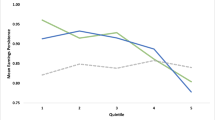Abstract
This paper evaluates the effects of binding regulatory restraints on the rate of performance-based management compensation within a banking framework in which a primary function of bank management teams is to monitor loans in order to eliminate deadweight default losses. Available management teams are endowed with heterogeneous levels of monitoring efficiencies, and obtaining services from more efficient monitoring teams requires payment of higher rates of performance-based compensation. In equilibrium, a fraction of banks choose to employ management teams that monitor. With or without binding capital requirements, imposing binding restraints on the allowed rate of performance-based compensation results either in lower bank efficiency or in a reduced fraction of monitoring banks and, hence, lower aggregate loan quality.



Similar content being viewed by others
References
Adler, J. (2010). FDIC board split on exec pay plan. American Banker, January 13.
Diamond, D. (1984). Financial intermediation and delegated monitoring. The Review of Economic Studies, 51, 393–414.
Diamond, D. (1991). Monitoring and regulation: the choice between bank loans and directly placed debt. Journal of Political Economy, 99, 689–721.
Elyasiani, E., Kopecky, K., & VanHoose, D. (1995). Costs of adjustment, portfolio separation, and the dynamic behavior of bank loans and deposits. Journal of Money, Credit and Banking, 27, 955–974.
Federal Deposit Insurance Corporation (2010). Incorporating employee compensation criteria into the risk assessment system, Advance Notice of Proposed Rulemaking 12 CFR Part 327, January 12.
Grant, C. T., & Grant, G. (2008). Can regulations curb excessive executive pay? Strategic Finance, September, 31–39.
Hill, J. (2009). New trends in the regulation of executive remuneration, Working Paper, Vanderbilt Law School.
John, K., Saunders, A., & Senbet, L. (2000). A theory of bank regulation and management compensation. Review of Financial Studies, 13, 95–125.
Kopecky, K., & VanHoose, D. (2006). Capital regulation, heterogeneous monitoring costs, and aggregate loan quality. Journal of Banking and Finance, 30, 2235–2255.
Kopecky, K., & Vanhoose, D. (2010). Can capital requirements induce private monitoring that is socially optimal? Working Paper, Temple University and Baylor University.
Macey, J., & O’Hara, M. (2003). The corporate governance of banks. Federal Reserve Bank of New York Economic Policy Review, 16, 91–107.
Mason, D. (2009). Why government control of bank salaries will hurt, not help, the economy, Backgrounder, Heritage Foundation, No. 2336, November 4.
Raviv, A., & Landskroner, Y. (2009). The 2007–2009 financial crisis and executive compensation: Analysis and a proposal for a novel structure, Working Paper, New York University, June 15.
VanHoose, D. (2011). Regulation of bank management compensation. In: J. Tatom (ed) Financial Market Regulation: Legislation and Implications. Springer, pp. 163–183.
Author information
Authors and Affiliations
Corresponding author
Rights and permissions
About this article
Cite this article
VanHoose, D. Regulatory Constraints on Performance-Based Managerial Compensation, Bank Monitoring, and Aggregate Loan Quality. Atl Econ J 39, 315–328 (2011). https://doi.org/10.1007/s11293-011-9290-2
Published:
Issue Date:
DOI: https://doi.org/10.1007/s11293-011-9290-2




